October 2025 Key Facts:
- Six years ago, fewer than 2,000 satellites were in service.
- +23% increase in acGve satellites over the past 12 months.
- Starlink’s 8,366 satellites (Elon Musk) account for 64% of all acGve satellites worldwide, up 31% in a year.
- China now counts 1,102 acGve satellites, a 25% rise in one year.
- The European Eutelsat OneWeb constellaGon numbers 651 satellites in orbit.
Based on data collected and processed by its SYNAPSE digital pla>orm, Look Up, a company specialized in space situaDonal awareness and deploying a global network of space-traffic surveillance radars, presents, in partnership with the weekly magazine Le Point, the first publicly released large-scale figures on orbital traffic.
With the conDnuous growth in launches and acDve satellites, the deployment of mega-constellaDons, the evolving balance of power among spacefaring naDons, and rising geopoliDcal tensions, the Look Up × Le Point Space Barometer highlights the major trends shaping orbital acDvity today.
“Space has never been as crowded and contested as it is today. Earth orbits have become a strategic domain where orbital traffic reflects the technological race, economic compeDDon, and geopoliDcal, someDmes even military, power struggles. With our Look Up × Le Point Barometer, we aim to reveal the data behind these dynamics and showcase tangible examples of the new race for space,” said Michel Friedling, Co-founder and CEO of Look Up.
Earth orbits becoming increasingly crowded
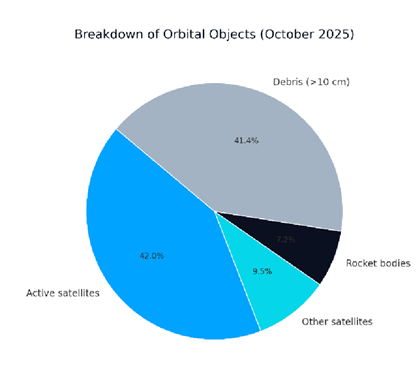
The past year set yet another record with 3,664 satellites launched.
As of October 1, 2025, there are 15,965 satellites catalogued around Earth, including 13,026 acGve satellites, a 23% year-onyear increase (+2,477 net new satellites, i.e., launches minus deorbiDng).
This surge illustrates the acceleraDng deployment of commercial constellaDons delivering telecommunicaDons and EarthobservaDon services.
It conDnues a long-term trend: just six years ago, fewer than 2,000 satellites were operaGonal.
United States Leads; China rapidly gaining ground
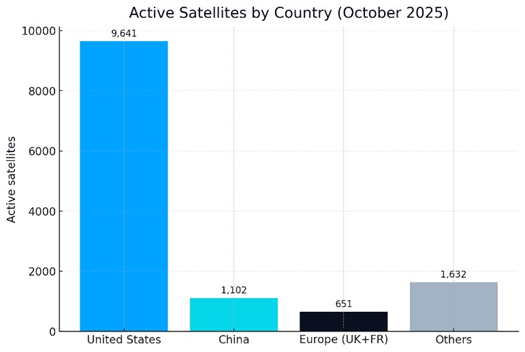
The country breakdown shows a clear U.S. dominance with 9,641 acGve satellites, nearly three-quarters of the total, driven primarily by SpaceX’s Starlink megaconstellaGon with 8,366 satellites, +1,963 in 2024 alone.
China is catching up with 1,102 acGve satellites (+25% in a year), notably deploying Starlink-like constellaDons such as QianFan (90 sats) and GuoWang (57 sats).
Europe ranks third, mainly with Eutelsat OneWeb’s 651 satellites, but lags far behind in terms of new launches.
DeorbiGng on the rise, but debris sGll abundant
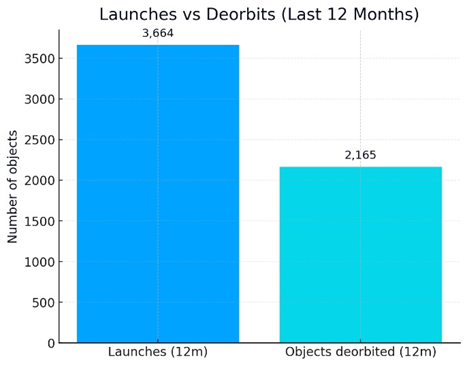
At the same Dme, 2,165 space objects (including 1,182 satellites and 109 rocket bodies) have been deorbited over the past twelve months.
However, these efforts have not curbed overall orbital populaDon growth: there are now 31,019 catalogued objects, including 12,833 debris over 10 cm.
It should be noted that European sensors are insufficient in terms of quality, quanDty, and distribuDon across the globe to detect and catalog all objects in Earth orbit and, as a result, there is a very high dependence on American data.
Look Up × Le Point Space Barometer #1 by the Numbers
General Figures as of Oct 1, 2025
- Total satellites in orbit: 15,965
- AcDve satellites: 13,026
- 12-month growth: +23% (+2,477 satellites)
- Total catalogued orbital objects (satellites, rocket bodies, debris > 10 cm): 31,019, including 12,833 debris
Launches & De-OrbitaGons
- Satellites launched in the past 12 months: 3,664
- Objects de-orbited: 2,165 (incl. 1,182 satellites, 109 rocket bodies) Breakdown by Country / ConstellaGon
- United States: 9,641 acDve satellites (+2,173 YoY)
- incl. 8,366 Starlink
- China: 1,102 acDve satellites (+220 YoY)
- incl. QianFan (90), GuoWang (57)
- Europe: 651 Eutelsat OneWeb
Other notable constellaDons: Kuiper (U.S. with 129 satellites)
Source: Look Up






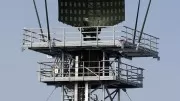

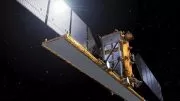
Be the first to comment on "Orbital traffic surges: 13,026 ac8ve satellites as of October 1, 2025"